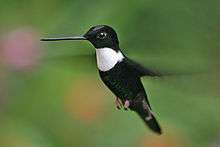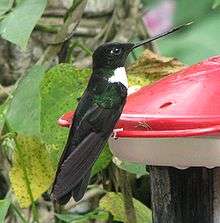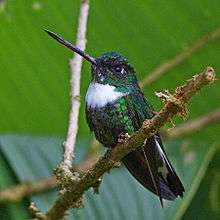Collared inca
| Collared inca | |
|---|---|
 | |
| Male hovering | |
_-NBII_Image_Gallery-a00189.jpg) | |
| Female | |
| Scientific classification | |
| Kingdom: | Animalia |
| Phylum: | Chordata |
| Class: | Aves |
| Order: | Apodiformes |
| Family: | Trochilidae |
| Genus: | Coeligena |
| Species: | C. torquata |
| Binomial name | |
| Coeligena torquata (Boissonneau, 1840) | |
The collared inca (Coeligena torquata) is a species of hummingbird found in humid Andean forests from western Venezuela, through Colombia and Ecuador, to Peru and Bolivia. It is very distinctive and unique in having a white chest-patch and white on the tail. Like other hummingbirds it takes energy from flower nectar (especially from bromeliads), while the plant benefits from the symbiotic relationship by being pollinated. Its protein source is small arthropods such as insects. It is normally solitary and can be found at varying heights above the ground, often in the open.[2]
The Gould's inca (Coeligena torquata omissa) of southern Peru and Bolivia is normally considered a subspecies of the collared inca, although it has a rufous (not white) chest-patch.[3]

Taxonomy

The collared inca is (controversially) placed in the order Apodiformes, which contains swifts as well as hummingbirds. It is in the family Trochilidae, that of the hummingbirds, and placed within the subfamily Trochilinae, the so-called "typical hummingbirds."[4]
Subspecies
Collared incas found in different parts of their range tend to have certain morphological features characteristic of that region, and are considered separate subspecies. From north to south along the Andes they are:[2][3][5]
- Coeligena torquata conradii – Venezuela. Much greener than typical, cinnamon-buffy throat with rufous-brown spots, smaller chest-patch, buffy belly.
- Coeligena torquata torquata – Colombia, east slope of Andes in Ecuador, and part of Peru.
- Coeligena torquata fulgidigula – West slope in Ecuador. Greener than typical. Patch on male's forehead shimmering blue. Male's chin metallic turquoise.
- Coeligena torquata margaretae – Central Amazonas Region of Peru to the Pasco Region of Peru. Two-part (shimmering green and blue) forehead patch in male. Female has white and green-spotted chin.
- Coeligena torquata insectivora – Pasco Region to the Ayacucho Region of Peru.
- Coeligena torquata eisenmanni – Within a relatively small area to the northwest of Cusco, Peru. Both genders have some coppery uppertail coverts. Male has black head except for crown. Female has rufous chin.
- Coeligena torquata omissa – From Cuzco south to the end of the range of the species in Bolivia. Gould's inca, sometimes considered a separate species, it is certainly the most distinctly different of all the subspecies, having in both genders a completely rufous, rather than white, chest-patch.
- Coeligena torquata inca may be an additional subspecies.[4]
Description
10–14 centimetres (3.9–5.5 in) in length, with a rather long (3–3.5 centimetres (1.2–1.4 in)), straight, black beak. Under most lighting conditions Coeligena torquata torquata appears black except for a very large and distinctive white chest-patch. However, in ideal lighting other features can be discerned: a shimmering metallic violet forehead patch in males, white thighs, fleshy-dusky feet, shimmering green throat in males, dull and containing some white in females, and some dark green mixed in with the black of the body. The tail of both genders is black except for white on the basal half of the outer four rectrices, and part of the underside. The female is slightly lighter green overall than the male and has a slightly smaller chest-patch[2][5]
Vocalizations are infrequent. Quiet, low-pitched, reedy whistle "tu-tee." Longer series of "pip... pip..." Very quiet spitting sound when foraging.[5]
Distribution and habitat
Humid subtropical and temperate forest regions, including cloud forests on both slopes of the Andes from Venezuela to Bolivia between 1,800 metres (5,900 ft) and 3,000 metres (9,800 ft), usually above 2,100 metres (6,900 ft) in Ecuador.[2][3] It typically forages below half the height of the canopy, and can most often be found around thickets near the forest edge.[2][5]
It is fairly common throughout most of its range.[2][3] No reasons for concern have been claimed.
Behavior
Diet
Like other hummingbirds, the collared inca obtains most of its energy from nectar, which it drinks while it in turn pollinates the flower, and feeds on insects and other small insect-like arthropods as a source of protein.[5] It seems to prefer epiphytes.[2] It is a solitary trap-liner, meaning that it forages alone by flying a routine route between several flowers.[5]
Breeding
Two single females of other Coeligena species have been observed caring for two offspring each. The nests were 1–2 metres (3.3–6.6 ft) above ground, about 7 centimetres (2.8 in) tall and wide, with an interior cup about 3 centimetres (1.2 in) deep and wide, and were composed of seed down and other materials. The eggs were completely white and measured about 1.5x1 cm. The mother visited once or twice every hour, to feed the young for a period of 9–55 seconds.[6][7]
References
- ↑ BirdLife International (2012). "Coeligena torquata". IUCN Red List of Threatened Species. Version 2013.2. International Union for Conservation of Nature. Retrieved 26 November 2013.
- 1 2 3 4 5 6 7 Greenfield, P.; Ridgely, R. (2001). The Birds of Ecuador. Ithaca, New York: Cornell University Press.
- 1 2 3 4 Schulenberg, T.; Stotz, D.; Lane, D.; O'Neill, J.; Parker, T. (2007). Birds of Peru (revised and updated ed.). Princeton, New Jersey: Princeton University Press.
- 1 2 "Coeligena torquata". Integrated Taxonomic Information System. Retrieved 1 July 2011.
- 1 2 3 4 5 6 Restall, R.; Rodner, C.; Lentino, M. (2006). Birds of Northern South America: An Identification Guide. London: A&C Black.
- ↑ Dyrcz, A.; Greeney, H. (2008). "Observations on the Breeding Biology of Bronzy Inca (Coeligena coeligena) in Northeastern Ecuador". Ornitologia Neotropical. 19: 565–571.
- ↑ Greeney, H.; Nunnery, T. (2006). "Notes on the breeding of north-west Ecuadorian birds". Bulletin of the British Ornithologists' Club. 126 (1): 38–45.
External links
- Collared inca videos on the Internet Bird Collection
- Range Map from Cornell Ornithology
- Stamps (for Ecuador) with RangeMap
- Photo-Med Res; Article
- Collared inca photo gallery VIREO
